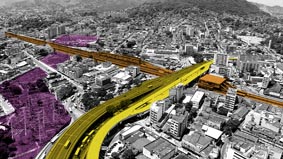Rio de Janeiro Metropolis
Architecture and infrastructure as supports for the territory project
DOI:
https://doi.org/10.24168/revistaprumo.v3i4.594Abstract
This article begins with the understanding of Rio de Janeiro as a plural metropolis, but marked by great inequalities imposed by urban dynamics implemented from the end of the nineteenth century to distinct parts of its territory and linked to various representations. These dynamics are related to developmental paradigms, expansion and optimization of the times of displacement, made possible by large infrastructural works. The practice of the project, in architecture and urbanism, appears, in this context, as an action capable of subverting parameters and instruments that promote uncontrolled expansion, loss of identity and formal indefinition. Infrastructures, especially mobility, are used as an opportunity to approach the problem, capable of supporting and promoting pre-existences whose potentialities can operate as alternatives to the already saturated and restricted Metropolitan Center, through the discussion of strategies designed to deal with physical-space complex and distinct from the traditional paradigms of architecture and urbanism.
Key-words: Urbanism, infrastructure, design strategies, metropolis, Rio de Janeiro.







